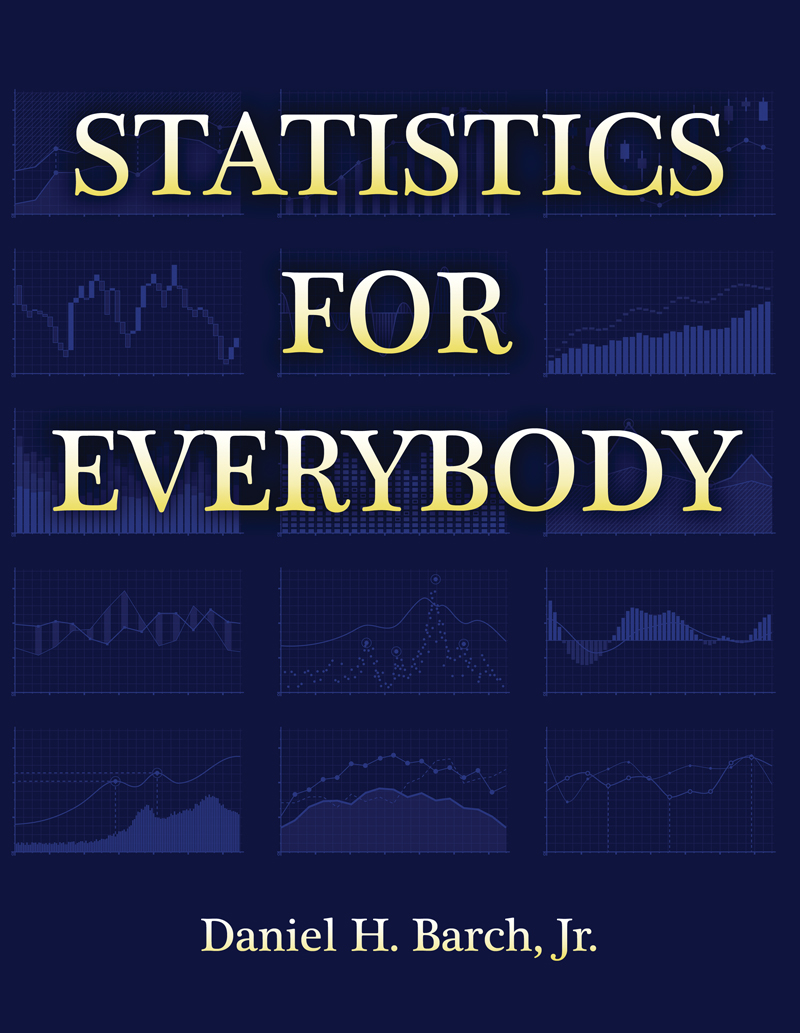Statistics for Everybody is an introduction to the field of applied statistics. Its goal is to explain the simple concepts, the complicated concepts, and all of the in-between concepts of introductory stats in plain and (hopefully!) entertaining language. To help guide the reader, the text contains helpful figures, examples, and the occasional joke (just to keep things moving along). It is meant to be a first textbook in college-level statistics, but - as the title says - it is meant to be read by everybody with an interest in learning (or learning more) about stats.
Topics covered in this text include probability theory, visual presentations of data, correlation, regression, t-tests, nonparametric statistics, and ANOVA. The text of each chapter is followed by review questions for conceptual understanding and practice problems. Detailed but easy-to-read statistical tables are included in the appendix.
Supplemental material contains lessons for performing statistical analysis and for visualizing data in the R programming language.
Introduction
An Essay About Some of the Terrible Ideas of Most of the People We Are Going to Discuss in This Book
Chapter 1. Statistics and Parameters
Samples and Populations
Sampling Methods
Statistics and Parameters
Statistics and Probability
Review Questions
Practice Problems
Chapter 2. Types of Variables
Categorical (Nominal) Data
Ordinal (Rank) Data
Discrete data
Interval data
Ratio data
Continuous (or scale or scalar) data
The relationship between data types
Descriptive Statistics
Central Tendency
Spread
Variance
Skewness
Kurtosis
Discussion Questions
Practice Problems
Chapter 3. Visual Representations of Data
Principles of Data Visualization
Data Visualization Tools
Bar Charts
Histograms
Box-and-whisker Plots
Scatterplots
Pie Charts
Choropleth Maps
Line Charts
Tables
Review Questions
Practice Problems
Chapter 4. Introduction to Probability Theory
Probability Terminology: A Starter Set
The Kolmogorov invalid source specified: Axioms
Methods of Assigning Probability
Rules of Probabilities Using Independent Events
Probability Trees
Permutations and Combinations
Review Questions
Practice Problems
Chapter 5. Odds
Odds: More Than Two Events
Odds Ratios
Applied uses of ORs
Review Questions
Practice Problems
Chapter 6. Conditional Probability
Unions and Intersections with Conditional Probability
Probability Trees and Conditional Probability
Bayes’s Theorem
Bayes’s Theorem and Scientific Reasoning
Review Questions
Practice Problems
Chapter 7. The Normal Distribution
The Normal Distribution
Features of the Normal Distribution
Percentiles
Linear Combinations of Normal Distributions
The Cumulative Normal Distribution
The Central Limit Theorem
Review Questions
Practice Problems
Chapter 8. Binomial Probability
Characteristics of the Binomial Distribution
The Combinatorial Explosion
The Normal Approximation to the Binomial
Proportions
Hypothesis Testing Using the Binomial
Types of Alternative Hypotheses
Six-step Hypothesis Testing Procedure
Review Questions
Practice Problems
Chapter 9. The χ 2 Test of Statistical Independence
Prologue: The Scientist Tasting Tea
Nonparametric statistics
When to Use Nonparametric Tests
The χ 2 Test of Statistical Independence
Notes on the χ 2 Test of Statistical Independence
The Two-way χ 2 Test of Statistical Independence
Beyond the Two-way χ 2 Test of Statistical Independence
Review questions
Practice Problems
Chapter 10. Assumptions of Parametric Tests
Assumption 1: Scale Data
Assumption 2: Normality
Homoscedasticity, or Homogeneity of Variance
Random Assignment
What do we do when assumptions are violated?
Review Questions
Practice Problems
Chapter 11. Correlation and Regression
Correlation
The Dimensionless r
Calculating r
Correlation Does not Imply Causation
Regression
The Proportionate Reduction in Error R2
Other Types of Regression
Review Questions
Practice Problems
Chapter 12. t-Tests
The t Distribution
Degrees of Freedom Associated with Sample Means
The t Distribution
The Basic Logic of t-Tests
One-Sample t-Tests
Repeated-measures or Within-Groups t-Tests
Independent-Samples or Between-Groups t-Tests
Review Questions
Practice Problems
Chapter 13. Confidence Intervals
Interpreting Confidence Intervals
Confidence Intervals on Means
Confidence Intervals on Proportions
Normal Approximation (Asymptotic Method)
Wilson Score Interval
Exact Method
Review Questions
Practice Problems
Chapter 14. Analysis of Variance (ANOVA)
One-way Independent-samples ANOVA
The F statistic
Calculations Involved in the One-way Independent-samples ANOVA
The One-way Independent-samples Model
Null and Alternative Hypotheses of One-way Independent-samples ANOVA
Assumptions of the One-way Independent-samples ANOVA
The ANOVA Table
Calculations for the One-way Independent-samples ANOVA
One-way Repeated-measures Analysis of Variance
Assumptions of the One-way Repeated-measures ANOVA
The One-way Repeated-measures ANOVA Model
Factorial Analysis of Variance
Calculation of the Factorial ANOVA
A Note on Factorial ANOVA
Post-Hoc Tests
Tukey’s HSD Test
Review Questions
Practice Problems
Chapter 15. Effect Size and Power
Effect Size
Effect Size for t-Tests: Cohen’s d
Effect Size for ANOVA: 2 η
Power
Power Analysis
Review Questions
Practice Problems
Appendix Table 1: Percentiles of the Standard Normal Distribution
Appendix Table 2a: Critical Values of the Fmax Test ( 0 α = .05)
Appendix Table 2b: Critical Values of the Fmax Test ( 0 α = .01)
Appendix Table 3: Selected Probability Values for the χ 2 Distribution
Appendix Table 4: Critical values of r
Appendix Table 5: Critical Values of the t-Distribution
Appendix Table 6a: Critical Values of the F-Distribution( 0 α = .05)
Appendix Table 6a: Critical Values of the F-Distribution ( 0 α = .01)
Appendix Table 7a: Critical Values of the Studentized Range Statistic q ( 0 α = .05)
Appendix Table 7b: Critical Values of the Studentized Range Statistic q ( 0 α = .01)
Answers to Practice Problems
A resident of Cambridge, Massachusetts, Dan Barch is a researcher at RTI International and a lecturer in the Psychology Department at Tufts University. He received a BS degree in Psychology from the University of North Carolina at Chapel Hill and MS and PhD degrees in Psychology from Tufts University. At Tufts, he has been a professor of introductory statistics, advanced statistics, experimental design, and human reasoning and decision making.
Dan has analyzed, synthesized, and visualized data in various scientific fields, including healthcare quality, addiction prevention and treatment, human memory, behavioral decision-making, perception of risk, and probabilistic reasoning.
Prior to his career in scientific research, Dan had been a crisis counselor for youth with behavioral disorders, an elementary school teacher, a high school teacher, a lifeguard, a fry cook, a bartender, a trivia host, a karaoke host, and an occasional jazz pianist.
Statistics for Everybody is the first book Dan has written.
Statistics for Everybody is an introduction to the field of applied statistics. Its goal is to explain the simple concepts, the complicated concepts, and all of the in-between concepts of introductory stats in plain and (hopefully!) entertaining language. To help guide the reader, the text contains helpful figures, examples, and the occasional joke (just to keep things moving along). It is meant to be a first textbook in college-level statistics, but - as the title says - it is meant to be read by everybody with an interest in learning (or learning more) about stats.
Topics covered in this text include probability theory, visual presentations of data, correlation, regression, t-tests, nonparametric statistics, and ANOVA. The text of each chapter is followed by review questions for conceptual understanding and practice problems. Detailed but easy-to-read statistical tables are included in the appendix.
Supplemental material contains lessons for performing statistical analysis and for visualizing data in the R programming language.
Introduction
An Essay About Some of the Terrible Ideas of Most of the People We Are Going to Discuss in This Book
Chapter 1. Statistics and Parameters
Samples and Populations
Sampling Methods
Statistics and Parameters
Statistics and Probability
Review Questions
Practice Problems
Chapter 2. Types of Variables
Categorical (Nominal) Data
Ordinal (Rank) Data
Discrete data
Interval data
Ratio data
Continuous (or scale or scalar) data
The relationship between data types
Descriptive Statistics
Central Tendency
Spread
Variance
Skewness
Kurtosis
Discussion Questions
Practice Problems
Chapter 3. Visual Representations of Data
Principles of Data Visualization
Data Visualization Tools
Bar Charts
Histograms
Box-and-whisker Plots
Scatterplots
Pie Charts
Choropleth Maps
Line Charts
Tables
Review Questions
Practice Problems
Chapter 4. Introduction to Probability Theory
Probability Terminology: A Starter Set
The Kolmogorov invalid source specified: Axioms
Methods of Assigning Probability
Rules of Probabilities Using Independent Events
Probability Trees
Permutations and Combinations
Review Questions
Practice Problems
Chapter 5. Odds
Odds: More Than Two Events
Odds Ratios
Applied uses of ORs
Review Questions
Practice Problems
Chapter 6. Conditional Probability
Unions and Intersections with Conditional Probability
Probability Trees and Conditional Probability
Bayes’s Theorem
Bayes’s Theorem and Scientific Reasoning
Review Questions
Practice Problems
Chapter 7. The Normal Distribution
The Normal Distribution
Features of the Normal Distribution
Percentiles
Linear Combinations of Normal Distributions
The Cumulative Normal Distribution
The Central Limit Theorem
Review Questions
Practice Problems
Chapter 8. Binomial Probability
Characteristics of the Binomial Distribution
The Combinatorial Explosion
The Normal Approximation to the Binomial
Proportions
Hypothesis Testing Using the Binomial
Types of Alternative Hypotheses
Six-step Hypothesis Testing Procedure
Review Questions
Practice Problems
Chapter 9. The χ 2 Test of Statistical Independence
Prologue: The Scientist Tasting Tea
Nonparametric statistics
When to Use Nonparametric Tests
The χ 2 Test of Statistical Independence
Notes on the χ 2 Test of Statistical Independence
The Two-way χ 2 Test of Statistical Independence
Beyond the Two-way χ 2 Test of Statistical Independence
Review questions
Practice Problems
Chapter 10. Assumptions of Parametric Tests
Assumption 1: Scale Data
Assumption 2: Normality
Homoscedasticity, or Homogeneity of Variance
Random Assignment
What do we do when assumptions are violated?
Review Questions
Practice Problems
Chapter 11. Correlation and Regression
Correlation
The Dimensionless r
Calculating r
Correlation Does not Imply Causation
Regression
The Proportionate Reduction in Error R2
Other Types of Regression
Review Questions
Practice Problems
Chapter 12. t-Tests
The t Distribution
Degrees of Freedom Associated with Sample Means
The t Distribution
The Basic Logic of t-Tests
One-Sample t-Tests
Repeated-measures or Within-Groups t-Tests
Independent-Samples or Between-Groups t-Tests
Review Questions
Practice Problems
Chapter 13. Confidence Intervals
Interpreting Confidence Intervals
Confidence Intervals on Means
Confidence Intervals on Proportions
Normal Approximation (Asymptotic Method)
Wilson Score Interval
Exact Method
Review Questions
Practice Problems
Chapter 14. Analysis of Variance (ANOVA)
One-way Independent-samples ANOVA
The F statistic
Calculations Involved in the One-way Independent-samples ANOVA
The One-way Independent-samples Model
Null and Alternative Hypotheses of One-way Independent-samples ANOVA
Assumptions of the One-way Independent-samples ANOVA
The ANOVA Table
Calculations for the One-way Independent-samples ANOVA
One-way Repeated-measures Analysis of Variance
Assumptions of the One-way Repeated-measures ANOVA
The One-way Repeated-measures ANOVA Model
Factorial Analysis of Variance
Calculation of the Factorial ANOVA
A Note on Factorial ANOVA
Post-Hoc Tests
Tukey’s HSD Test
Review Questions
Practice Problems
Chapter 15. Effect Size and Power
Effect Size
Effect Size for t-Tests: Cohen’s d
Effect Size for ANOVA: 2 η
Power
Power Analysis
Review Questions
Practice Problems
Appendix Table 1: Percentiles of the Standard Normal Distribution
Appendix Table 2a: Critical Values of the Fmax Test ( 0 α = .05)
Appendix Table 2b: Critical Values of the Fmax Test ( 0 α = .01)
Appendix Table 3: Selected Probability Values for the χ 2 Distribution
Appendix Table 4: Critical values of r
Appendix Table 5: Critical Values of the t-Distribution
Appendix Table 6a: Critical Values of the F-Distribution( 0 α = .05)
Appendix Table 6a: Critical Values of the F-Distribution ( 0 α = .01)
Appendix Table 7a: Critical Values of the Studentized Range Statistic q ( 0 α = .05)
Appendix Table 7b: Critical Values of the Studentized Range Statistic q ( 0 α = .01)
Answers to Practice Problems
A resident of Cambridge, Massachusetts, Dan Barch is a researcher at RTI International and a lecturer in the Psychology Department at Tufts University. He received a BS degree in Psychology from the University of North Carolina at Chapel Hill and MS and PhD degrees in Psychology from Tufts University. At Tufts, he has been a professor of introductory statistics, advanced statistics, experimental design, and human reasoning and decision making.
Dan has analyzed, synthesized, and visualized data in various scientific fields, including healthcare quality, addiction prevention and treatment, human memory, behavioral decision-making, perception of risk, and probabilistic reasoning.
Prior to his career in scientific research, Dan had been a crisis counselor for youth with behavioral disorders, an elementary school teacher, a high school teacher, a lifeguard, a fry cook, a bartender, a trivia host, a karaoke host, and an occasional jazz pianist.
Statistics for Everybody is the first book Dan has written.




